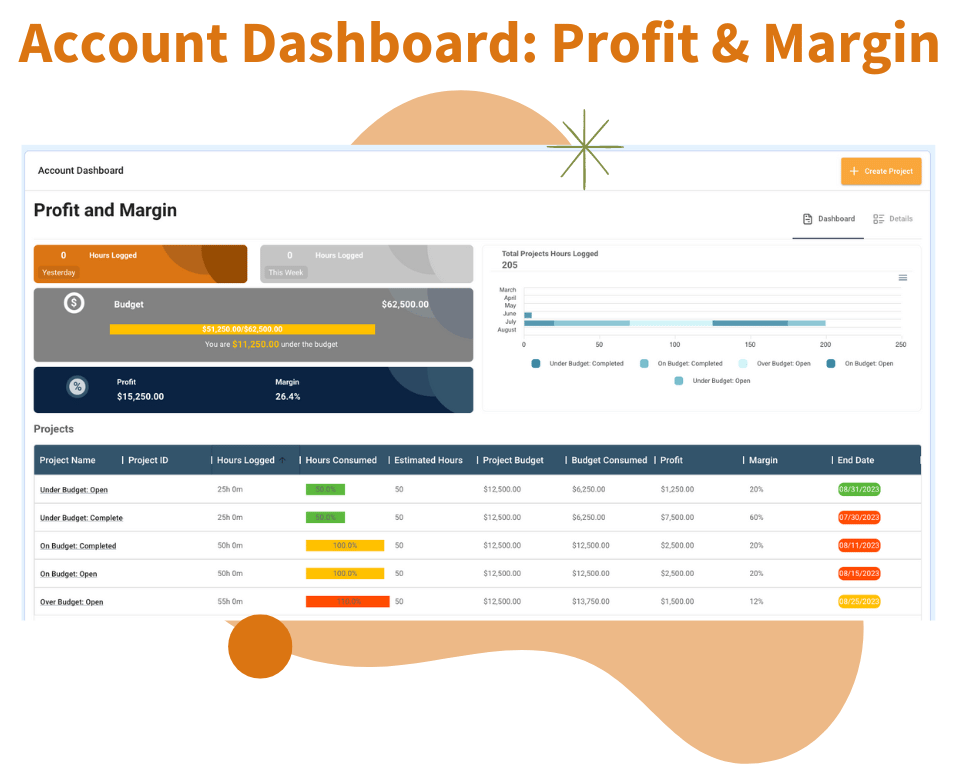Introduction
Where does profit and margin come from
In this article, we’ll explore the concepts of profit and margin in projects and how they are calculated. Understanding these financial metrics is crucial for managing the bottom line of your business. We’ll focus on how project statuses play a significant role in tracking profit and margin, especially in Fixed Fee projects.
So let’s dive into how Dinvy Ascent helps you properly manage your profit and margin numbers with Project Statuses.
Project Statuses
The general use case for tracking projects
For efficient project management, mastering the utilization of Project Status updates is essential. These updates serve as a project’s GPS, offering crucial insights into its current state, progress through different phases, and any potential delays or advancements toward the go-live milestone.
Here’s how to make the most of Project Statuses:
- Regular Updates: Ensure that project statuses are consistently updated by the project team members. This allows for real-time visibility, helps identify bottlenecks, and keeps everyone on the same page.
- Clear Milestones: Define clear milestones and link them to specific project statuses. This way, you can accurately track progress and measure achievements against predetermined goals.
- Effective Communication: Encourage open communication within the team and stakeholders, using project statuses as a common language to discuss project health, challenges, and priorities.
By combining Project Statuses with Contract Types (how you bill for a project) and monitoring of profit and margin, you gain a powerful tool to manage your bottom line effectively.
Project Statuses & Profit in Time and Material (T&M) Projects
How profit and margin is generated
In T&M projects, profit and margin are relatively straightforward to understand. The calculations are based on the rates applied to the hours billed. For example, if you bill $200 per hour and the cost is $150 per hour for 10 hours of work, the profit would be $500, and the margin would be 25%.
$200 / $150 x 10 hours
$2,000 billed / $1,500 cost
Profit of $500 / Margin of 25%
A T&M project, or hourly engagement, has an “adaptive budget” or really, a budget goal. Your profit and margin are not against the estimate budget revenue but what is actually billed.
When you close out your project, a crucial step is to conduct a comprehensive review of your budget estimate in comparison to the actual billing (whether it was under, over, or on target).
This analysis provides invaluable insights into your resource planning and allocation for the project, offering a deeper understanding of how well your project was managed from a financial standpoint.
Project Statuses in Fixed Fee Projects
Using Project Statuses in Fixed Fee projects
Fixed Fee projects require a more nuanced approach to track profit and margin. In these projects, the budget is fixed, and profit and margin can change depending on whether the project comes in under or over budget.
Dinvy Ascent automates these calculations for you while a Project Status is Open: In Progress and then when it is Closed: Completed.
The below example illustrates how profit and margin are calculated in a Fixed Bid project.

Open Projects
When a Project’s Status is OPEN (Over Budget) – Profit and Margin are calculated against the Gross Cost Amount against the Budget. While profit and margin were at a steady 25% before, once your Cost goes over the budget, your profit and margin decline.
When a Project’s Status is OPEN (Under Budget) – Profit and Margin are calculated in the traditional manner Bill Rate / Cost Rate x Hours = Profit and Margin
Closed Projects
When a Projects Status is CLOSED (Over Budget) – Profit and Margin are calculated against the Gross Cost Amount against the Budget.
When a Projects Status is CLOSED (Under Budget) – Profit and Margin are now calculated to include the remainder of the budget! When you close the project, you are not actively billing time to the client so if you’ve only billed a cost of 30 of your projected 50 hours, you now have a margin of 55%! You are able to claim the additional revenue as Profit to your bottom line.
Conclusion
Revenue Recognition and Managing Projects
This process of claiming revenue on a Fixed Bid project is your first step into a deeper understanding of your businesses finances. You may decide to dive deeper into this world with Revenue Recognition and Accrual Accounting or by implementing Operating Expenses into your overall Revenue and Margin on your own but; for now, Dinvy Ascent helps you with this first automated process.
For managing your Fixed Bid projects, consider these strategies to mitigate overages and maximize underages:- Real-time Monitoring: Regularly track project status and financials to identify any deviations from the budget.
- Proactive Management: If the project is trending towards an overage, take immediate actions to control costs and reallocate resources.
- Leveraging Opportunities: When a project is under budget, explore opportunities to utilize resources more efficiently and potentially take on additional work.
Understanding project status and its connection to overages and underages in Fixed Bid projects is essential for effective budget management, team member management and project profitability.
By leveraging project status information, project managers can make informed decisions, optimize project outcomes, and achieve greater financial success. Proactive monitoring and thoughtful management can lead to improved profit margins and successful project deliveries.
We are always available for any questions you may have regarding best practices for your organization and are happy to be a sounding board! Feel free to reach out through our contact form, or directly via the contact information below:
Timothy Schmitt
Director of Sales | Dinvy, LLC
tim.schmitt @dinvy.com | 414.313.0601
Timothy is a fanatic of all things process related and passionate about problem solving. He takes great pride in helping others hone in on their pain points and delivering solutions that result in greater profitability and operational efficiency.


